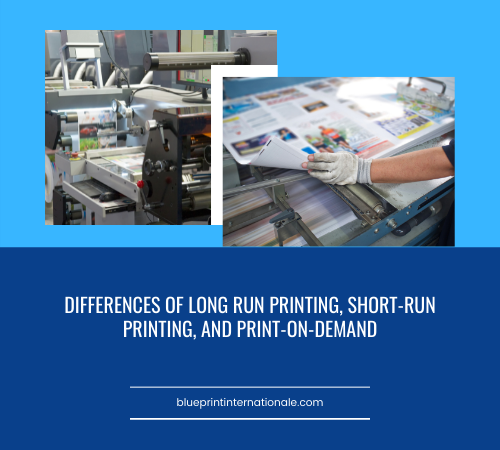Finally, your book is ready for publication. You have spent months or years laboring over your material and selecting the right design flourishes that proclaim “this is my book.” Now comes one of the most thrilling selections- the moment in which your book becomes a tangible object that you can touch in your hands. You currently have a material that you can proudly display and proclaim, “I created this.” Let us work together to make it a reality.
Throughout the publication process, many choices must be taken into account. When it comes to publishing your book, another issue will arise. Three (3) printing methods are available in terms of volume: long-run printing, short-run printing, and print-on-demand (POD) printing; each method has its benefits and drawbacks, and each will complement the marketing and sales tactics you use. Consider each of the following options:
Short-Run Printing
It refers to publications produced in quantities fewer than thousands. Although, of course, publishing 999 books is not a joke. Certain printers will print a limited edition of as little as ten volumes.
Short-Run Printing: Advantages
- Immediate Turnaround Time
It is simple to set up and maintain. This speeds up production and guarantees that your printed materials are completed and ready to ship as quickly as feasible. - Affordability
While more significant print runs continue to provide more excellent value per unit, short-run printing has become very cheap, making it a viable choice for businesses of all sizes. Because less investment is required in short-run printing, it lowers the amount of money a firm must spend on the print job. - Allows for Publication of New Versions
Choosing short-run printing makes it far simpler to keep your book’s material current. Businesses should utilize up to 400 copies before it is time for an update if they print 100 to 400 copies. Minor changes are feasible with each short-run print, ensuring that the information remains as useful and accurate as possible. - Storage Space is Conserved
While storing thousands of books takes a significant amount of storage space, you will not require as much room to keep printed books in the short-run printing. This may be critical for businesses with tiny workplaces and those who want to keep clutter to a minimum. - Reduced Waste
Additionally, it contributes to waste reduction. Businesses may order a few books, enabling them to sell or dispose of a whole run before the material becomes obsolete. This minimizes the likelihood of companies being left with books they cannot utilize and allows printers to reduce needless waste. Not only is this beneficial for your business and the printer, but you are also helping the environment.
Short-Run Printing: Disadvantages
The primary drawback of short-run printing is the associated expense. Its projects have a greater unit cost than long-run printing. However, this does not imply it is a poor option; it all relies on the specific project’s requirements. Typically, clients will choose short-run printing if they are uncertain about their ability to use all their print materials.
Long-Run Printing
Long-run printing occurs when you submit your files to a printing company (referred to as an “offset printer”), which prints your book in bulk. The recognized standard for long-run printing is about 1,000 books. This is seldom advised for newly self-published writers. Use this approach only if you already have a sizable following and are sure that all of them will eventually sell. Authors who have already published more than one book and have a big established following may choose this option. Another kind of author who may profit from a long-run print is a well-known public speaker or local celebrity — someone whose name or brand already handles the majority of the marketing for them.
Long-Run Printing: Advantages
The primary advantage of a long-run print is its cost. The more books you print, the greater the discount. Consider purchasing your book in quantity. However, similar to other bulk-oriented retail warehouses, this is only lucrative if your goods can be moved rapidly.
Additionally, an offset printer allows you greater control over the quality of your book. An expert will monitor the outcome to guarantee correctness. There is less opportunity for color and placement variation.
Long-Run Printing: Disadvantages
One thing to consider when working with a printing business is the cost of delivery. Certain printers will not send your books for free, so you will need to budget for this or pick them up personally. Here’s hoping your vehicle has some cargo room. And if you decide to sell your books online after having them sent to you, you will be responsible for shipping them to your reader. You’ve just paid for mailing your book twice.
You don’t want a garage full of books you may or may not sell. While that price may seem attractive at first, if you wind up selling just a few hundred copies or worse, you may find yourself running at a loss. Then it would be best if you determined what to do with all the books accumulated in your home. These are some expensive roller coasters.
What happens if you discover an error? Perhaps an errant semicolon has intruded into a sentence to which it was not welcome. If you are utilizing pre-printed books (short or long run), you will have to stop selling the copies with the mistake and absorb the expense, or you will have to pray no one notices before ordering another run. This is much worse in the long term since you will have many books with the error.
Print-on-Demand (POD) Printing
Asking when you should utilize print-on-demand is a very straightforward question to answer. If you want to distribute your book, this is a prudent course of action. Print-on-demand (POD) is a phrase that refers to the process through which a book is automatically produced after being bought online. For instance, Amazon KDP print, the print-on-demand (POD) service provider, will print the book to your specifications and send it straight to the customer.
Print-on-Demand (POD) Printing: Advantages
Print-on-demand is quickly gaining popularity as a way of publishing books for self-publishers. It is not required to keep pre-printed books in some musty corner, nor are you responsible for overstocking.
Additionally, if you are using print-on-demand, errors are simple to rectify. With print-on-demand, you can immediately repair the mistake and ensure that all subsequent copies contain the proper text.
Print-on-Demand (POD) Printing: Disadvantages
Why would you not use print-on-demand? The solution may be contingent upon your desire for the dissemination of your book. If you plan to sell this item only at events or a book you intend to present as a gift to a family member or beloved ones; you may opt to avoid print-on-demand.
Print-on-demand does not provide the same degree of quality control. This includes everything from color quality to the positioning of the book’s design components. Expect a 2% variation in these components- almost imperceptible, but this is a pain for designers to consider.
Finding the right company that offers quality and affordable book marketing and publishing services is easy with Blueprint Press Internationale. Pick up your phone and dial (888) 617-8289 to know more. You can also go to blueprintinternationale.com for more details.




